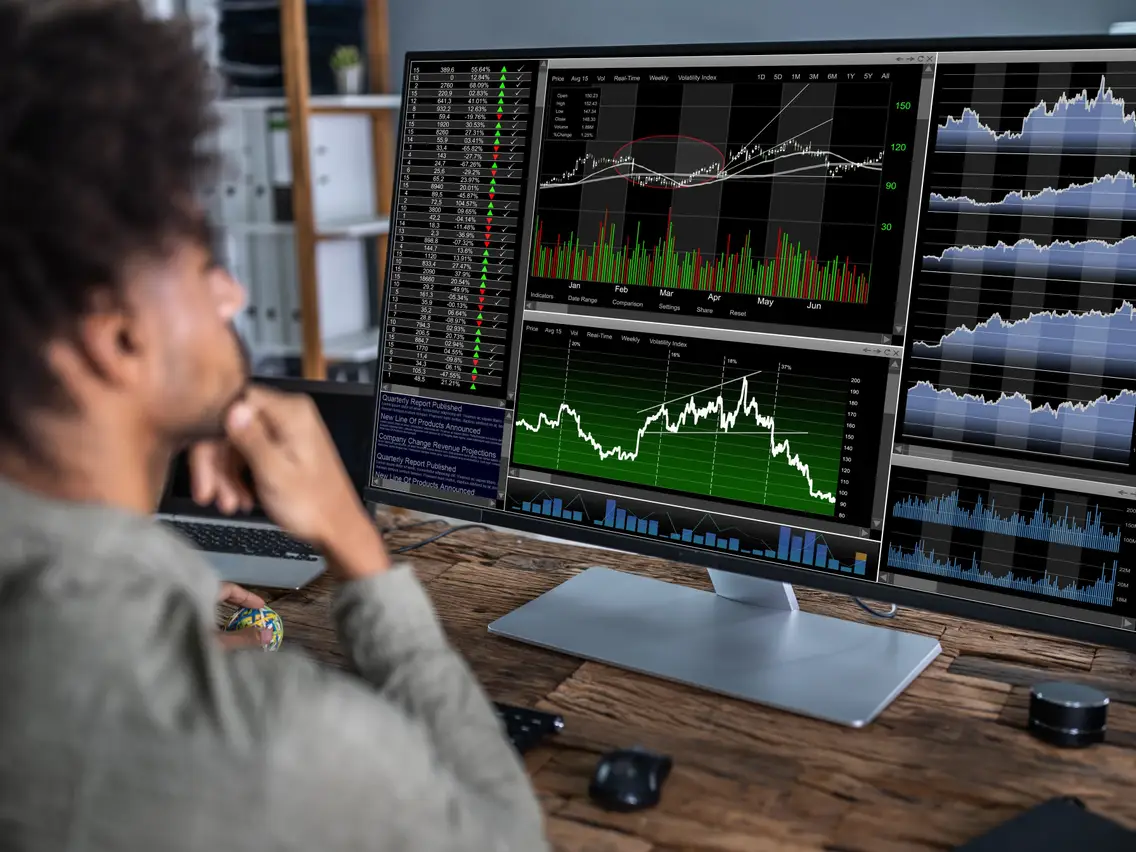Day trading has attracted many who seek the thrill of buying and selling financial assets within the same day. It offers the potential for quick profits, but it also comes with a higher risk factor.
If you’re new to the world of trading, there’s a lot to learn before you can jump in. This guide will walk you through the basics, giving you the foundation you need to start. By the end, you’ll know the tools, strategies, and skills that successful traders use daily.
Key Points
- Start small with a focus on learning, not profits.
- Understand the market and the assets you are trading.
- Practice through simulators before committing real money.
- Establish a trading plan with clear rules.
- Use reliable charting software to track market trends.
- Monitor news and global events for potential market shifts.
What is Day Trading?

Day trading involves buying and selling stocks or other financial assets within the same day. Unlike traditional investors, traders look to profit from short-term price movements. They don’t hold positions overnight, so the focus is entirely on intraday price action.
This style of trading requires focus, knowledge, and discipline. Without preparation, it’s easy to lose money. Many beginners start with the hope of fast profits, only to quickly realize that success depends on learning the strategies and building experience.
Learning From Trusted Sources
It’s important to learn from reliable sources if you’re serious about day trading. Warrior Trading is one of the largest communities of active traders. It offers online courses and training that make it easier to understand, even for beginners.
With step-by-step training programs, it helps people build skills in a structured way. Instead of jumping in blindly, consider taking advantage of such resources. You’ll build a better understanding of the market, reducing costly mistakes.
Tools You Need to Get Started
You can’t succeed without the right tools. Starting out, you’ll need specific software and accounts to begin your trading journey.
1. Brokerage Account

The first step is opening a brokerage account. This is the account where you’ll place trades. Many brokers today offer platforms geared towards beginners. You want to choose one that has low fees, quick execution, and a user-friendly interface. A good broker will offer detailed charts, news feeds, and fast order execution.
2. Trading Platform
The platform is your command center. This software allows you to view charts, monitor the market, and place trades. Some brokers offer their own platforms, while others support third-party software. Look for features like real-time data, order types, and a smooth user interface. Spend time learning the layout, as you’ll need to act quickly during market hours.
3. Charting Software
Charts are critical for identifying trends and making informed decisions. They help visualize price movements and provide clues about future directions. You need software that offers candlestick charts, technical indicators, and drawing tools. Many platforms come with these features built-in. Others may require a separate subscription.
4. High-Speed Internet Connection
Day trading requires quick action. You need fast internet to ensure orders are placed instantly without delay. Even a slight delay could cost you a profitable trade. If possible, use a wired connection for more stability.
Start With Simulated Trading

Before risking real money, use a simulator. Many platforms offer demo accounts where you can practice with virtual money. Simulated trading helps you understand how the market moves.
You’ll also get a feel for order execution and the emotions tied to profit and loss. Think of it as training before stepping onto the real field. Practicing can help build your confidence and teach you valuable lessons without financial risk.
Develop a Solid Trading Plan
This is your set of rules that define how and when you’ll trade. It removes emotion from decisions, helping you stick to logical and tested strategies. Your plan should cover what assets you’ll focus on, how much capital you’ll risk per trade, and when you’ll enter or exit positions.
Setting Entry and Exit Points
Every trade needs an entry and exit point. You don’t want to make decisions on the fly. Instead, set specific price levels where you’ll enter a trade. Likewise, define when you’ll exit. This could be when the asset reaches a certain price or when the technical indicators signal that momentum has shifted.
Stop-Loss Orders
A stop-loss order automatically closes a trade if the price moves against you. This protects you from major losses and ensures you only lose a small portion of your capital per trade. Always place a stop-loss when you enter a trade. It’s a simple rule that can prevent significant damage to your account.
Limit Your Risk Per Trade
Never risk your entire account on a single trade. A good rule is to limit risk to 1-2% of your total capital per trade. That way, even if you lose, it won’t hurt your overall balance. Over time, this approach helps protect your account from large losses.
Strategies to Consider

There are different strategies for day trading. Which one you use depends on your style and market conditions. Here are a few popular methods to get started:
1. Scalping
Scalping focuses on making small, quick profits. Traders look for tiny price movements and execute many trades throughout the day. Profits may be small per trade, but they add up over time. Scalping requires focus and quick decision-making. It’s best suited for traders who can watch the market closely throughout the day.
2. Momentum Trading
Momentum traders look for assets moving strongly in one direction. They buy when prices are rising and sell when the trend shows signs of slowing. The goal is to ride the momentum of the asset and exit before it reverses.
3. Breakout Strategy
This strategy looks for key price levels where the asset breaks out of a defined range. When the price breaks through a support or resistance level, traders enter positions expecting the price to move in the direction of the breakout.
Monitor News and Global Events

Markets move on the news. Unexpected events can cause large price swings, both up and down. As a trader, it’s important to stay informed. Regularly check financial news, earnings reports, and global events. News can impact an asset’s price, providing opportunities for both gains and losses.
Learn From Your Trades
Every trade, win or lose, offers a lesson. After each session, review your trades. Ask yourself what went right and what could be improved. Keeping a journal of trades can help track your progress over time. This habit allows you to spot mistakes and make adjustments, refining your strategy for future success.
Stay Committed to the Process
Like any skill, day trading takes time to master. Don’t expect overnight success. Stay committed to learning and improving. Some days will be tough, but staying consistent and disciplined will lead to progress. Stay patient and keep your goals in sight. With the right mindset and tools, you can become a successful trader.









